Caring for paper objects
Sherry Guild
Caring for paper objects is part of CCI's Preventive conservation guidelines for collections online resource. This section presents key aspects of managing the care of paper objects in heritage collections based on the principles of preventive conservation and risk management.
Table of contents
- Understanding paper objects and how they are damaged
- Causes of damage to paper objects and preventive conservation strategies
- Examples of preventive conservation practices
- Bibliography
List of abbreviations and symbols
Abbreviations
- ASTM
- American Society for Testing and Materials
- CCI
- Canadian Conservation Institute
- ICOM-CC
- International Council of Museums – Committee for Conservation
- ISO
- International Organization for Standardization
- portable document format
- PET
- poly(ethylene terephthalate)
- PP
- polpropylene
- RH
- relative humidity
- UV
- ultraviolet
Symbols
- mm
- millimetre
- nm
- nanometre
- µW/lm
- microwatt per lumen
Understanding paper objects and how they are damaged
Paper objects form a significant part of our cultural heritage. A collection may include letters, legal records, newspaper clippings, stamps, bank notes, maps, illustrations and architectural plans. A collection can also have pictorial objects such as posters, postcards, advertisements, prints, pastels, drawings, sketches and paintings on paper or card. Paper objects are at risk of deterioration, damage and loss because of inherent instability, poor environmental conditions and improper handling and storage. When caring for paper objects in a collection, it is important to recognize these risks and to take measures to ensure the preservation of those objects.
Deterioration of paper
Paper is defined as a substance made in the form of thin felted sheets from fibrous plant material such as cotton, linen, straw or wood. All of these fibre types contain cellulose, the basic component of paper. Cellulose is a natural polymer (a large molecule that is formed from repeating units of smaller molecules) of glucose units linked together to form chains comprising 2000–4000 units. Plant sources that contain long fibres of relatively pure cellulose can be made into correspondingly stronger papers.
Linen rags and, later, cotton were traditionally used to make paper in the West. They produced very high-quality, strong, handmade papers with long fibres and generally very few impurities or harmful chemicals. However, the demand for paper eventually outgrew the sources of linen or cotton rags and, since the mid to late 19th century, most Western papers (with some exceptions) have been machine-made using shorter wood fibres. Eastern papermakers used different plant fibre materials, such as the traditional Japanese papermaking fibres gampi, mitsumata and the particularly long-fibred kozo from the paper mulberry tree (Figure 1).
In addition to shorter fibres, wood pulp produces a paper that may contain lignin, which causes discolouration of the paper. Manufacturing methods for wood pulp paper that are acidic in nature, such as groundwood pulp, will produce a poor-quality paper. Today, however, paper that is comparable to rag paper in longevity can be made from highly processed chemical wood pulp, usually with the addition of an alkaline material such as calcium carbonate.
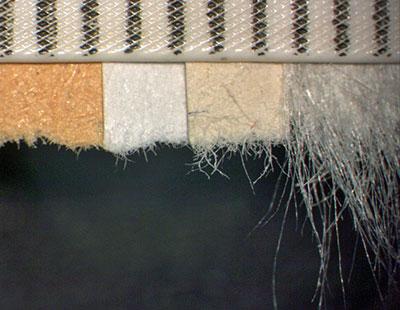
© Government of Canada, Canadian Conservation Institute. CCI 129965-0003
Figure 1. Detail showing four different types of paper made with plant fibres of various lengths. Left to right: short-fibred, brittle groundwood pulp paper; new office paper made of recycled chemical wood pulp fibre; modern rag fibre paper; and modern kozo fibre paper. Magnification 16X. The scale at the top is in millimetres.
The longevity of paper is influenced, in part, by the paper fibre and method of manufacture. Some of the best papers are made from plant cells that are long-fibred and high in cellulose, but each fibre has its own characteristic and lends certain attributes to the paper. Other functional additives such as fillers, sizing agents, dyes, optical brighteners, wet- and dry-strength additives as well as papermaking process additives such as retention or drainage aids, biocides, dispersants and defoamers will also affect paper quality and aging.
The greatest determinant of the condition of paper remains the integrity of the cellulose fibres. The cellulose polymer is prone to chemical and physical damage that weakens the fibre network on a submicroscopic level, eventually manifesting in visible degradation. The principle mechanism of deterioration is chain scission (the long polymer is reduced to shorter and shorter segments); as this happens, the paper begins to lose its physical strength and may become discoloured. As the aging of paper decreases the length of the underlying cellulose chains and therefore the paper fibres, papers that started with longer fibres can undergo further aging before losing mechanical strength.
There are two main pathways that cause chemical deterioration of paper: acid-catalyzed hydrolysis and oxidation. Acid-catalyzed hydrolysis is greatly accelerated by an increase in acidity of the paper substrate or in relative humidity (RH). Oxidation is accelerated by metal contaminants, pollutants, bleach residue from manufacturing, or light. The ultimate result of chemical deterioration is loss of strength and change in appearance. At normal human comfort temperatures (20°C) and moderate RH levels (50%), the rate of deterioration can cause significant damage in a few decades or less if the paper is acidic or heavily contaminated (e.g. metal contaminants, bleach).
Deterioration of media
As well as the paper substrate, image and text media are vulnerable to deterioration, damage or loss.
Friable media: charcoal, pastel, chalk, graphite
Avoid direct contact with all friable media (Figure 2), such as charcoal, soft pastel, chalk and soft graphite, as this can cause losses, abrasions or smudges since there is little or no binder and their adhesion to paper is tenuous. The whole image aesthetic could be altered from this type of damage, often caused by improper handling or by improper matting and framing techniques. In particular, static from incautious use of common glazing (instead of anti-static glazing) and inappropriate framing methods (lack of window mat and spacer) can cause serious losses. Precautions are necessary to minimize vibration and shock during handling, display and storage.
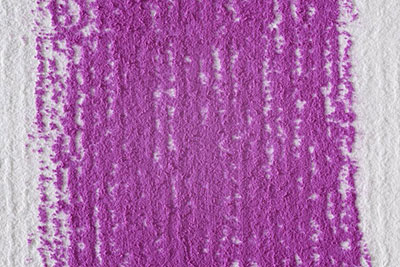
© Government of Canada, Canadian Conservation Institute. CCI 124703-0076
Figure 2. Detail of a pastel, showing the friable media on the surface of the white paper fibres, which is vulnerable to smudging.
Watercolour
Pure watercolour is a thin transparent wash of finely powdered pigment in a water-soluble gum binder, usually gum arabic. Applied with water, it penetrates the paper and remains transparent (Figure 3). As a paint medium, watercolour can be very stable, but many of the pigments used, especially organic ones, are extremely sensitive to light. Because watercolour is often very thinly applied, even slight fading is apparent.
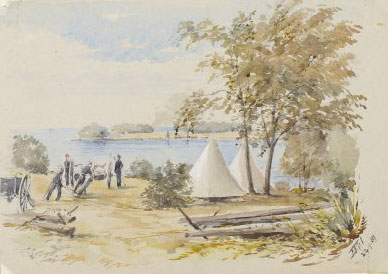
© Government of Canada, Canadian Conservation Institute. CCI 120078-0023
Figure 3. Detail of a watercolour from the Royal Canadian Artillery Museum. Watercolour penetrates the paper but remains transparent and often relies on the white or neutral colour of the paper support to reflect light outward.
Gouache
Gouache can be described as opaque watercolour. Pigments and fillers are combined with a water-soluble binder to produce a paint often applied in a thicker film than watercolour. Unlike watercolour, gouache rests on the surface of paper, forming a distinct layer. Thick applications are prone to cracking and flaking (Figure 4). The porous, matte surfaces will hold dirt and dust and are difficult to clean.
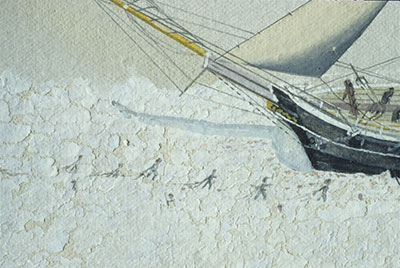
© Government of Canada, Canadian Conservation Institute. CCI 2003216-0001
Figure 4. Detail of a gouache showing damage to the paint layer.
Ink
Iron gall ink is made from a combination of gallnut (small, hard swellings on oak trees) extract, iron sulfate, gum arabic and water. Gallnuts provide gallic and tannic acids that react with the iron salts in the presence of oxygen to form the ink colourant: an initially blue-black complex that shifts towards brown with age.
On some objects, the presence of iron gall ink has caused ink corrosion with subsequent degradation to the paper. This degradation process is the result of two substances in the iron gall ink: iron(II) ions and acids. In the presence of moisture or high RH, the iron(II) ions and acids may migrate from the ink into the surrounding paper, thereby increasing the area of ink corrosion. Areas of iron gall ink corrosion may be in poor condition, with cracks and losses at the ink lines (Figure 5).
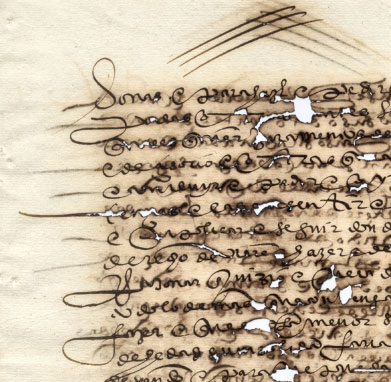
© Government of Canada, Canadian Conservation Institute. CCI 124703-0089
Figure 5. Deterioration of paper by iron gall ink.
Modern inks may contain synthetic dyes, pigments, solvents, binders and additives. Inks made from dyes or from some sensitive pigments are fugitive (they fade quickly) if exposed to light.
Causes of damage to paper objects and preventive conservation strategies
This section describes the causes and types of damage to paper objects and the preventive conservation strategies that reduce the risks of damage.
Holistic preventive conservation strategies
Often, single preventive conservation strategies provide holistic benefits, i.e. they address several preventive conservation issues. Establishing protocols for the use and handling of paper objects in a collection, providing protective enclosures as well as providing clean, secure and stable storage conditions are three key holistic preventive conservation strategies that mitigate the effects of virtually all agents of deterioration.
Use of the collection and handling
Paper is vulnerable to physical damage from improper or careless handling. Tears, creases, smudged media and broken corners may occur if the paper object is handled carelessly (Figure 6). Direct hand contact also means that there is a transfer of oils, salts and possibly minute amounts of soiling from the fingertips that will accumulate with time and disfigure the object. There is also the risk of inadvertent staining. Careless handling is one of the greatest causes of damage to paper objects and perhaps the easiest to control.
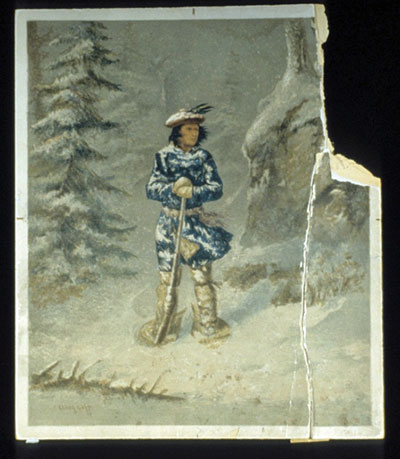
© Government of Canada, Canadian Conservation Institute. CCI 124703-0084
Figure 6. Watercolour on acidic card backing. The damaged corner was probably the result of careless handling.
If handling of collections is controlled and regulated, much physical damage and soiling can be reduced or eliminated. The basic rules are to avoid unnecessary handling and displacements and to always use rigid supports when objects need to be moved (Figure 7).
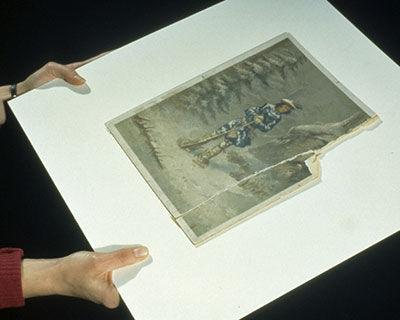
© Government of Canada, Canadian Conservation Institute. CCI 124703-0085
Figure 7. Moving a paper object on a rigid support.
The handling of paper objects should always be undertaken with care. One should plan the route and move slowly and deliberately. Both hands should always be used for transporting or handling. Oversized objects, such as posters, maps or large prints, are particularly vulnerable to damage due to their size.
If the collection is accessible to the public (e.g. researchers), precautions should be taken to ensure that there is no accidental damage. Furniture should be provided in the study area for safe examination, and it should be easy to clean. Visitors should be instructed by staff on the safe and correct way to handle paper objects. Access and handling procedures should be posted in the study area. These may include:
- no food or drink near paper objects
- no markers or ballpoint pens
- no direct contact unless supervised by authorized personnel
- use of a reserved, clear table for examination and a small tabletop easel to view matted or framed paper objects
Recommendations
- Handle objects as little as possible.
- Use clean cotton gloves, or wash hands well before handling.
- Use both hands to handle paper objects.
- Keep loose paper objects resting on a solid support while displacing them; hold them securely between two solid supports when turning them over.
- Plan the route for moving paper objects, and move slowly and deliberately.
- Use trolleys for transporting large or heavy items.
- Carefully organize oversized works and clearly label their folders to prevent excessive handling.
- Write out a set of handling procedures, and ensure compliance of all users. Post the handling procedures in the study area.
- Staff must be on hand to give all visitors instructions on the safe and correct way to handle paper objects. In particular, it must be clear that staff must always assist researchers in unfolding, unrolling and unfastening paper objects.
- Ensure that furniture used to examine objects in the study area has smooth surfaces, is easy to clean and is large enough to spread objects out on. Avoid cleaning products that may leave an oil or wax residue.
- Make reproductions (e.g. photocopies, photographs, digital images) of paper objects too fragile to handle or of those which are frequently accessed to replace the originals as standard reference documents for visitors.
- Make use of enclosures tailored to reduce direct handling during access (window mats, frames, encapsulation, etc.), as described below.
Enclosures
The use of protective enclosures is a key strategy in the preservation of paper objects. In enclosing objects, the effects of physical handling, contaminants (dust, fingerprints, pollutants), light and incorrect RH can be mitigated. Enclosures can also provide shielding that may help if potentially catastrophic events strike but are quickly contained, such as smoke from a small fire or a temporary increase in RH caused by a power outage or by a water leak in another part of the building.
An effective means of increasing the level of protection is to provide double or triple enclosures (Figure 8). For example, house artworks in window mats and provide folders, frames, boxes and cabinets for additional protection.

© Government of Canada, Canadian Conservation Institute. CCI 124703-0075
Figure 8. Protect paper documents with enclosures, e.g. provide window mats and sturdy archival-quality boxes.
Paper artworks with friable media require specialized matting and framing procedures, such as anti-static glazing and a window mat or spacer, to protect their fragile surfaces from abrasion, smudging or contact with the glazing.
Recommendations
- House paper objects in protective enclosures or folders made from buffered paper or board or from plastics, such as poly(ethylene terephthalate) (PET) or polypropylene (PP). Loose items are particularly vulnerable and should be protected in folders. A few similar objects can be placed in one folder.
- House acidic paper objects separated or isolated from adjacent paper objects.
- Store oversized paper objects flat in folders, either in metal horizontal cabinets or on wide metal shelves. Sufficient space should be allowed in the area where they are stored to remove them safely from the drawers or shelves and to ensure that there is space to set them down.
- House objects (e.g. artworks) in window mats, where appropriate. Window mats provide maximum protection without direct handling and can be used to view and transport the object. Provide a window cover to block light and protect from dust, pollutants and RH.
- Frame objects where appropriate (Figure 9). A window frame will provide additional protection from damage due to handling, will act as a buffer from minor fluctuations of temperature and RH and will prevent the intrusion of dust and airborne particles. If possible, retain the original frame and glazing as they help preserve historical evidence.
- EncapsulationFootnote 1 is appropriate for some paper objects. It allows the object to be viewed without removing it from the enclosure and minimizes handling stress. As well, it is especially effective in reducing RH fluctuations over several days since it is sealed. However, paper objects with friable media (pastels, chalk, charcoal, graphite) should never be encapsulated.
- Use archival storage boxes, shelving and cabinets to provide additional protection for paper objects housed in folders, sleeves or window mats (Figure 10). Well-designed dense storage with close stacking in closed cabinets is especially effective in reducing RH fluctuations over many days, even weeks.
- Choose or design well-tailored and well-sealed boxes. Boxes vary greatly in their enclosure effectiveness.
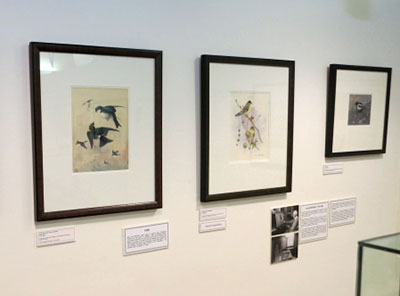
© Government of Canada, Canadian Conservation Institute. CCI 126672-0003
Figure 9. Framing paper artworks that are going on display protects them from multiple agents of deterioration.
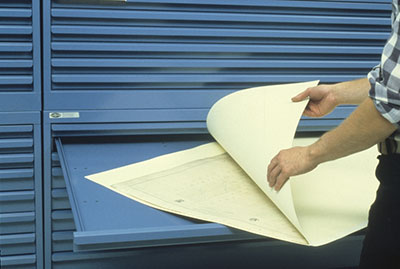
© Government of Canada, Canadian Conservation Institute. CCI 124703-0094
Figure 10. Flat metal storage cabinet for large paper objects.
For further details on boxes and enclosures or the matting and framing of works of art on paper, consult:
- CCI Note 11/1 Making Enclosures for Books and Paper Objects
- CCI Note 11/2 Storing Works on Paper
- CCI Note 11/3 Glazing Materials for Framing Works on Paper
- CCI Note 11/4 Wheat Starch Paste
- CCI Note 11/5 Matting Works on Paper
- CCI Note 11/6 Removing Paper Artifacts from Their Frames
- CCI Note 11/9 Framing Works of Art on Paper
Housekeeping and pest control
Practising good housekeeping is essential; dust can very easily end up soiling paper objects and reducing their aesthetic value. Dust is also a source of fungal spores and nutrients that can attract pests. Regular housekeeping and building maintenance is a key to eliminating pest issues.
Recommendations
- Conduct regular inspections of objects on display and in storage. At the first sign of pests, action must be taken to eliminate them.
- Remove and quarantine infested materials.
- Eliminate foodstuff and beverages from storage and display areas.
- Examine all incoming objects, building materials and packing cases.
- Use dust covers, protective enclosures, storage boxes and furniture to keep collections dust-free.
- If appropriate, and with sufficient expertise, paper objects may be surface cleaned to remove dust and grime.
Damage and preventive conservation strategies per agent of deterioration
This section describes the 10 agents of deterioration and their effects on paper and associated media, as well as the preventive conservation strategies that can help reduce damage to paper objects.
Physical forces
Paper objects are easily damaged if exposed to direct physical forces, such as during transportation and moves or during access and handling (as discussed under Use of the collection and handling and Enclosures).
Recommendations
- Instruct users in safe handling, as discussed under Use of the collection and handling.
- Use storage enclosures, boxes, window mats and frames, as discussed under Enclosures.
- Avoid exposure to handling and use by making reproductions of selected material.
- Ensure that sturdy shelving, cabinets and display cases are used.
- Ensure that the floor of any new planned storage area can sustain the loads (paper and archival collections can be heavier than the norm).
- Implement general preventive conservation strategies against risks due to physical forces (consult Agent of deterioration: physical forces).
- Identify items which, due to their nature or condition, are at higher risk of damage from physical forces and enhance their controls (e.g. friable media requires strictly controlled handling and limited travelling and physical transportation).
Theft, vandalism, dissociation
Some paper objects may be at higher risk of theft, vandalism or dissociation than others. Small pieces are typically at higher risk of being misplaced or stolen, while valuable pieces are typically at high risk of being stolen or disfigured. Landmark historical documents (charters, treaties) or artworks which may be interpreted as provocative (e.g. nude drawings) are typically at higher risk of vandalism.
Dissociation occurs, for example, if the accession number or associated information is lost or if some sheets in a document become separated from the rest.
Recommendations
- Apply glazing using glazed frames and/or display cases as it provides a common means of protecting paper objects against certain forms of vandalism.
- Implement general preventive conservation strategies for preventing theft and vandalism and for preventing dissociation (consult Agent of deterioration: thieves and vandals and Agent of deterioration: dissociation).
- Identify items at higher risk, and enhance their protection.
Fire, water
Paper and archival collections present a high risk in terms of fire hazards. Fire can result in total loss or extensive damage, including scorching, charring and soot deposits (Figure 11).
Exposure to water, whether due to a roof or water pipe leak, a flood or the use of sprinklers or water hoses (during fire control or by accident), can also be hugely damaging and can result in total loss of collections. Types of damage include loss or bleeding of media, water stains (Figure 12), cockling and surface deformations, delaminations and mould growth.
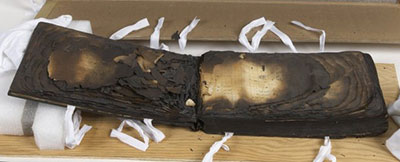
© Government of Canada, Canadian Conservation Institute. CCI 95678-0004
Figure 11. Partially burnt documents.
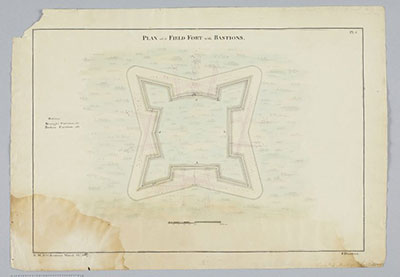
© Government of Canada, Canadian Conservation Institute. CCI 124877-0009
Figure 12. Water stain along the lower edge of a document, before treatment at CCI.
Recommendations
- Use heat and smoke detectors connected to a central system.
- Place fire extinguishers near exits.
- Train staff in fire prevention techniques.
- Install an automatic sprinkler system.
- Implement a fire safety program in consultation with local authorities.
- Inform authorities of gallery layout and location of valuable artworks.
- Inspect and maintain the automatic sprinkler system, roof and plumbing.
- Keep artwork off the floor and away from water sources.
- Prepare a disaster plan, store emergency supplies and establish emergency response for wet objects.
A more complete view of preventive conservation strategies to prevent damage to heritage collections from fire and water can be found under Agent of deterioration: fire and Agent of deterioration: water.
Pests
Insects and rodents find paper collections an attractive source of nutrients and have great potential to damage paper objects. The most common insect enemies of paper are silverfish, cockroaches, booklice and bookworms (larvae of any of about 160 species of beetles) (Figures 13a, 13b, 13c and 13d). They are attracted not only to paper (cellulose) but also to glues, sizes and certain media.
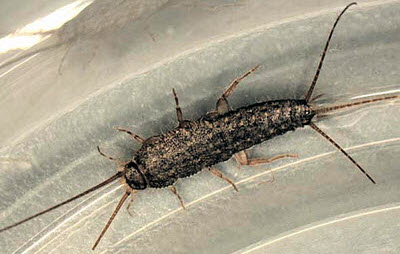
© Government of Canada, Canadian Conservation Institute. CCI 129965-0004
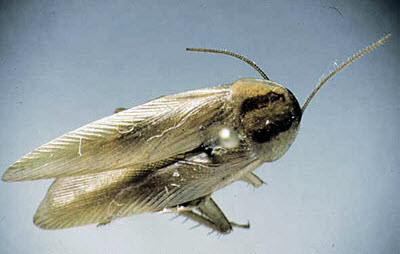
© Government of Canada, Canadian Conservation Institute. CCI 129965-0005
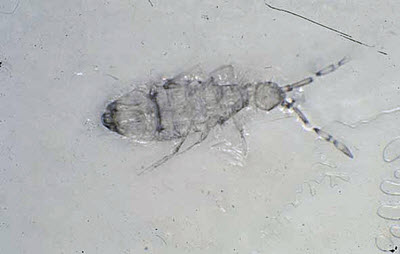
© Government of Canada, Canadian Conservation Institute. CCI 129965-0006
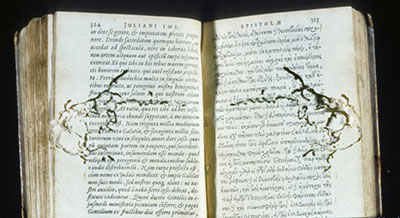
© Government of Canada, Canadian Conservation Institute. CCI 124703-0092
Figures 13a, 13b, 13c and 13d. Top three images show insects that attack paper: a silverfish, a cockroach and a booklouse (psocid). Bottom image: Bookworm damage to paper.
Booklice (psocids) are small insects (1–1.5 mm). They infest books and paper and are associated with high humidity, which allows fungal and mould growth, the main food of booklice. The presence of silverfish is also a sign of high humidity problems in the collection.
Rodents damage paper when they use it as a food source and as a nesting material. Their fecal matter and urine is especially damaging to paper. Unprotected paper objects, such as books or a map in a historic schoolroom, may be at greater risk of damage from pests.
Mould is a very important consideration for paper collections. It is discussed under Incorrect relative humidity.
Recommendations
- Practise good housekeeping (consult Housekeeping and pest control).
- Do not allow food or drink in storage or exhibit areas.
- Practise good building maintenance.
- Examine incoming objects, building materials and packing cases.
- Quarantine objects suspected of being infested; treat infested objects.
- Implement an integrated pest management program (consult Agent of deterioration: pests).
Pollutants
Cellulose is highly absorbent and readily takes in any gas that surrounds it. The most important airborne pollutants for cellulose are nitrogen dioxide and ozone (Figure 14). Some gaseous pollutants can also damage certain colourants such as alizarin crimson, basic fuchsin, curcumin and pararosaniline base. Hydrogen sulfide is particularly known for the darkening of the pigment white lead (basic lead carbonate) due to the formation of lead sulfide. Fine particles in the air such as soot are also a threat to paper collections.
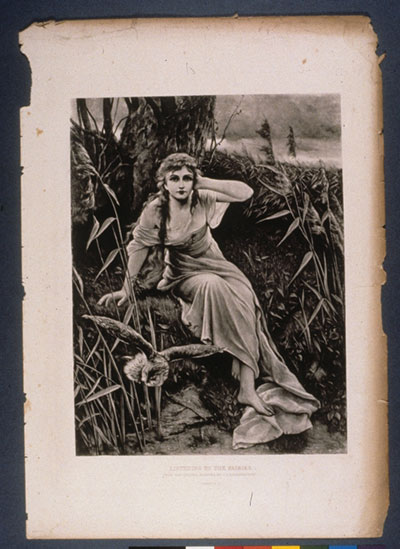
© Government of Canada, Canadian Conservation Institute. CCI 124703-0087
Figure 14. Discolouration on the fore-edge of a plate from a book. Fore-edges are the most exposed sections of a book to the surrounding air. Thus, pollutants will discolour the paper in these areas (top and side edges as seen in image).
Paper can be damaged from prolonged contact with chemically unstable storage and display materials, e.g. from pollutant gases emitted by wood, coatings, acidic enclosures and boxes or other objects found within the museum (Figure 15). Misguided adhesive tape repairs (Scotch tape, masking tape) will also stain and embrittle paper objects (Figure 16).
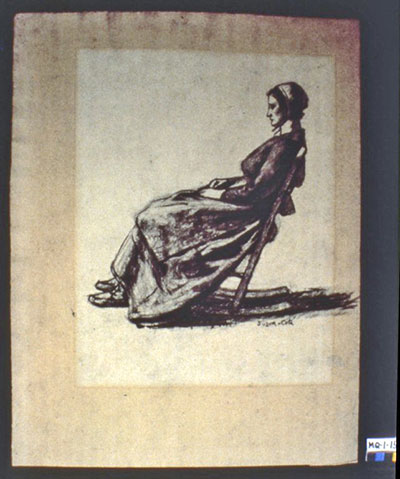
© Government of Canada, Canadian Conservation Institute. CCI 124703-0054
Figure 15. This artwork on paper has been stained by prolonged contact with an acidic matboard window. A buffered acid-free matboard would have prevented the stain.

© Government of Canada, Canadian Conservation Institute. CCI 126198-0027
Figure 16. The darker bands forming a cross in the middle of this document are staining from old tape repairs.
Dust and fingerprints are also potential sources of damage, as they can become ingrained, can stain and can obscure or disfigure paper objects (as discussed under Use of the collection and handling and Housekeeping and pest control).
Recommendations
- Protect paper objects from dust using dust covers, storage boxes and furniture, and implement good housekeeping practices (consult Housekeeping and pest control).
- Provide enclosures, airtight cases, frames, etc. (consult Enclosures).
- Handle paper objects with gloves or washed hands.
- Ensure that all storage materials used in contact with paper objects or near such objects are chemically stable. For long-term preservation, avoid using acidic mats (Figure 15), acidic interleaf paper or acidic cardboard boxes, as well as metal staples or paperclips, rubber bands or adhesive tapes. Paper enclosures (mats, folders and boxes) made of cotton rag or chemically purified wood pulp with a 3% calcium carbonate alkaline buffer are suitable for most paper objects. Exceptions include paper objects that contain dyes, pigments or inks sensitive to high alkalinity; these require products with no alkaline buffer. Consult also Technical Bulletin 32 Products Used in Preventive Conservation.
- When choosing plastics for enclosures, use only stable plastics that are free of plasticizers, such as PET (e.g. Melinex) or polypropylene.
- Avoid materials and finishes that are sources of pollutants, such as formic acid or acetic acid.
For further general preventive conservation strategies to protect paper collections from pollutants, consult Agent of deterioration: pollutants.
Light and ultraviolet
Visible light
Visible light (radiation that is visible to the naked eye) fades colours often found on paper objects and artworks (Figure 17). Fugitive colourants may be found in felt tip pen drawings, ink drawings and watercolours. Visible light can also fade dyed and coloured papers. Table 1a ranks the visible light sensitivity of paper substrates and of a range of colourants used in works of art on paper and other paper objects.

© Government of Canada, Canadian Conservation Institute. CCI 124703-0083
Figure 17. Example of two identical prints. The one on the left was sheltered from light and dust; the one on the right was left unprotected and has faded and become soiled.
|
Sensitivity |
Types of materials at risk |
|---|---|
|
High sensitivity (Materials rated ISO Blue Wool 1, 2 or 3) |
|
|
Medium sensitivity (Materials rated ISO Blue Wool 4, 5 or 6) |
|
|
Low sensitivity (Materials rated ISO Blue Wool 7, 8 or higher) |
|
|
No sensitivity |
|
Note: Table 1a is based on Table 3 in CCI's Agent of deterioration: light, ultraviolet and infrared.
Table 1b provides the expected fading for various light exposure scenarios, depending on the visible light sensitivity of a material (consult Table 1a for the sensitivity level of each material). As noted in Table 1b, if the light levels are reduced, for example from 5000 lux to 50 lux, this will significantly prolong the enjoyment of colours; if, instead, only the UV is filtered out of the light (compare the third column “With UV” to the fourth column “No UV”), this will have a beneficial but much more limited effect.
Highly sensitive colours (e.g. some felt tip pen inks) fade so fast that they can disappear within as little as a few hours of direct sunshine or within just a few years at low museum lighting. Watercolours, which are made of thin washes of colour, are in general in the high-sensitivity category, as even slight fading will be apparent in the thin washes of colours that have intermediate or poor light stability. Note, however, that even if using the lowest light level (50 lux) without any UV, colours in the high-sensitivity range may nevertheless fade within a few years if continuously displayed, and those in the medium-sensitivity range, within decades; that is why limiting exposure times is also very important to preserve sensitive colours as long as possible. On the other hand, some pigments, such as charcoal and graphite, do not fade even in direct sunshine (but the paper substrate, which is deemed to be in the low-sensitivity category, would be affected by such high light intensity). Microfading analysis provides a means of determining an artwork’s true fading rates.
| Sensitivity* | Visible light level | Time1 for just noticeable fade2 | |
|---|---|---|---|
| With UV3 | No UV4 | ||
High sensitivity |
30,000 lux (average daylight) |
0.8 to 7 days |
1 to 14 days |
5000 lux (light from a window or study lamp) |
4 days to 1 month |
5 days to 2 months |
|
500 lux (office lighting) |
5 weeks to 1 year |
7 weeks to 2 years |
|
150 lux |
20 weeks to 3.5 years |
6 months to 7 years |
|
50 lux |
1 to 10 years |
1.5 to 20 years |
|
Medium sensitivity |
30,000 lux (average daylight) |
5 days to 10 weeks |
2 weeks to 1 year |
5000 lux (light from a window or study lamp) |
3 weeks to 17 months |
2 months to 7 years |
|
500 lux (office lighting) |
8 months to 14 years |
2 to 70 years |
|
150 lux |
2 to 40 years |
7 to 200 years |
|
50 lux |
7 to 140 years |
20 to 700 years |
|
Low sensitivity |
30,000 lux (average daylight) |
1 to 14 months |
6 months to 10 years |
5000 lux (light from a window or study lamp) |
0.5 to 8 years |
3 to 70 years |
|
500 lux (typical office lighting) |
5 to 84 years |
30 to 700 years |
|
150 lux |
17 to 240 years |
100 to 2000 years |
|
50 lux |
50 to 840 years |
300 to 7000 years |
|
No sensitivity |
No fading expected whatever light level or exposure times used. |
||
* Consult Table 1a for materials at risk. |
|||
Note: Table 1b is based on Tables 3 and 4 in CCI’s Agent of deterioration: light, ultraviolet and infrared.
Ultraviolet radiation
Ultraviolet (UV) radiation contributes to the fading of colours, but its main damaging effect is to cause yellowing, weakening, chalking and/or disintegration of media. Disintegration or chalking of binders is often mistaken for pigment fading. UV radiation also causes yellowing and embrittlement of paper; newsprint and poor-quality paper are the most sensitive to this damage. For example, lignin in groundwood pulp papers makes them very vulnerable to damage from sunlight (which contains high levels of UV light) and will cause the paper to darken and yellow. Table 2 provides a snapshot of the effects of UV radiation on different components of paper objects and various scenarios of the time required for damage.
|
Sensitivity: ultraviolet |
Damage to materials |
Time1 required to produce damage by exposure scenario2 |
|---|---|---|
|
Very high |
- Yellowing of some low-quality papers, such as newsprint |
|
|
High |
- Chalking and weakening of most paints that contain photosensitizing pigments (zinc white, early titanium white) |
|
|
Medium |
- Weakening and fragmentation of most paper |
|
|
Low |
- Cracking and chalking of modern paints that contain UV stabilizers designed for outdoor exposure |
|
|
1These time estimates are derived from estimates based directly on observations outdoors (30,000 lux, natural UV levels of ~600-1000 µW/lm) by considering the lux level together with data on the wavelengths that cause the damage. The numbers provided are cautious. The phrase "or more" means that the actual time for most material–lighting combinations may be much longer. Each day of exposure is assumed to be 8 hours; each year, 3000 hours. 2 Notes on the four different scenarios:
When UV is measured as a ratio—microwatts (of UV energy) per lumen (of visible light)—then the total UV exposure, and the damage that it causes, depends on both this UV measurement and the intensity of visible light. Therefore, preserving materials from UV damage requires not just UV filtering (which only affects the ratio of UV within the light), but also reducing visible light levels (in lux). |
||
Note: Table 2 is based on Table 5 in CCI's Agent of deterioration: light, ultraviolet and infrared.
For a visual estimate of how colourants fade when exposed to visible light with or without UV, see CCI’s Light damage calculator. For further information on the sensitivity of paper, colourants and media to visible and UV light, consult Agent of deterioration: light, ultraviolet and infrared – Deterioration by light, UV, and IR.
Recommendations
In order to minimize light damage, the intensity, duration and UV content of the light should be monitored and controlled. Fading rates of the various paper objects should be estimated and consequently exposure times and schedules should be established. A light sensitivity rating of each object (i.e. high, medium, low or no sensitivity as discussed in Tables 1 and 2) should be based on both substrate and media (including the various different pigments). The most sensitive element of the object is used to establish the overall sensitivity to light.
Once the light sensitivity of the object is estimated, a decision regarding exposure time can be made. Examples of such lighting policies for works of art on paper have been published (Colby 1992; Derbyshire and Ashley-Smith 1999; Ashley-Smith et al. 2002; Ford and Smith 2011). For example, light-sensitive paper objects could be restricted to six months of exhibition time, at low light and UV levels, over five years. It is, therefore, important to keep track of the cumulative exposure time for paper objects. Note that highly sensitive colourants used on paper artworks can fade within less than 20 years even at low museum light levels (50 lux, no UV); thus, preserving their colour requires strict proactive controls, e.g. tightly rationed display schedules plus motion detectors that switch on and off as visitors approach artwork for viewing.
In summary:
- Estimate sensitivities and fading rates of various objects and establish a schedule for exposure times.
- Establish desired light and UV levels (if possible, aim for no UV), and adjust the lighting accordingly. Monitor and record light and UV levels in all exhibition areas.
- Keep a record of the cumulative light exposure doses, especially for highly sensitive items.
- Reduce exposure by rotating objects on display after a maximum time limit. Keep some representative objects out of the rotation so that they remain pristine indefinitely, for future research and to make facsimiles.
- Use facsimiles for display where appropriate.
- In study rooms, cover up or put away those objects not actively in use.
- Avoid unnecessary exposure to light by using timers and task lighting, turning off lights in the storage area when not in use, turning on gallery lights only during exhibition hours or covering display cases with curtains that can be pushed aside for viewing.
- Frame paper objects behind UV-filtering glazing, where appropriate.
- Filter out all UV light.
Incorrect temperature
Heat accelerates chemical reactions (such as oxidation and hydrolysis) that can lead to degradation of paper (yellowing, embrittlement). In general, all papers benefit from the reduced rate of chemical degradation that cooler temperatures or cool storage provide. A rule of thumb is that chemical degradation is slowed down by half with a 5°C decrease in temperature.
Obviously, the most acidic papers degrade the fastest and, as such, most urgently need this type of benefit. Where possible, cold or cool storage is best for highly acidic materials such as newsprint (Figure 18) or post-1850 low-quality books and papers. Research has found that if the life of acidic paper were 50 years at 25°C (a relatively reasonable estimate), it doubles to 100 years at 20°C and would be 500 years at 10°C and 5000 years at -15°C.
In the case of works on paper inscribed with iron gall ink, these will benefit from cool, dry storage to help slow down the deterioration caused by the ink.

© Government of Canada, Canadian Conservation Institute. CCI 129965-0002
Figure 18. Example of an acidic paper for which human comfort temperatures are too high for long-term preservation. When photographed, this newspaper was only 27 years old. Only cold storage can keep such objects well-preserved for much more than one human generation.
However, low temperatures can be a problem for any paper object that has a thick layer of media that might become brittle (in particular, gouache or acrylic paint). Applied wax seals on documents are also prone to embrittlement at low temperatures. This is also a consideration for travelling exhibitions during the cold Canadian winter months.
Note: keep in mind that temperature has a direct influence on RH. Low temperature will cause RH to increase.
Recommendations
- Identify which objects/collections are unstable (e.g. due to acidity) and whether they can be provided with cool or cold storage to last more than a few decades.
- Provide cooler room temperatures (even a couple of degrees lower provides long-term benefits) or cool or cold dry storage where appropriate.
- Install temperature recorders near the objects, and monitor and interpret the data.
- Avoid sunlight.
- Avoid using tungsten spotlights as they increase the temperature where they strike the object.
For further preventive conservation strategies that involve temperature, consult Agent of deterioration: incorrect temperature.
Incorrect relative humidity
High relative humidity
Mould spores are ubiquitous but remain dormant in dry environments. However, with high RH, mould will become active and digest sizes, surface coatings, various media and cellulose. Active mould derives its nutrients from organic matter by exuding an acidic liquid that breaks down the substrate into digestible matter. Once attacked, paper can become limp and pulpy. As a living organism, active mould may also produce coloured by-products that can cause irreversible staining (Figures 19 and 20).Consult Agent of deterioration: incorrect relative humidity, which provides a chart indicating the rate of mould growth by humidity level.
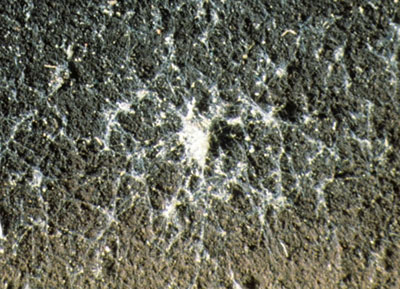
© Government of Canada, Canadian Conservation Institute. CCI 2005201-0001
Figure 19. Detail of mould growth on a pastel artwork.

© Government of Canada, Canadian Conservation Institute. CCI 124703-0088
Figure 20. Paper document weakened and stained by mould growth.
Damp conditions will also lead to cockling of paper. At very high RH (90–100%), ink dyes and watercolours run the risk of bleeding.
High RH also increases the breakdown of chemically unstable papers, resulting in discolouration and physical degradation. Collections on acidic paper (newsprint and poor-quality paper post-1850) benefit the most from being stored at low RH. Research has found that at 20°C and 30% RH, the lifespan of a typical wood pulp paper is twice what it would be at 20°C and 50% RH.
Works on paper inscribed with iron gall ink will benefit from cool, dry storage.
Relative humidity fluctuations
Paper objects try to maintain equilibrium with surrounding humidity levels. They absorb water vapour from the air when the RH increases and release water vapour when it decreases. This absorption and desorption of water vapour causes dimensional changes (swelling and shrinking). Paper and paint media can each have their own sensitivity and reaction rate to RH changes. Some paper objects are made of materials or components which are joined together but react very differently to RH. In these cases, large RH fluctuations can cause damage (Figure 21). Examples of vulnerable objects are provided in Table 3. A common high-risk situation consists of artworks that were pasted onto their backing, stretcher or frame (Figure 21) rather than being properly hinged; as a consequence, large RH fluctuations create stresses in the areas where the paper is restrained, which can lead to cockling or tearing.
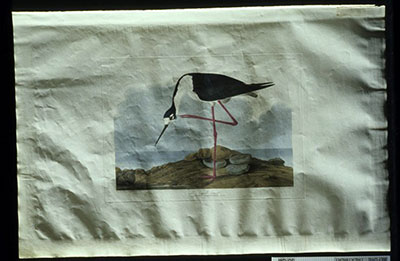
© Government of Canada, Canadian Conservation Institute. CCI 73870-0012
Figure 21. An intaglio print, where the back of the paper support was reinforced with a cloth tape repair; this produced a highly RH-sensitive object. When the object was later exposed to high RH, the paper was prevented from moving, which resulted in extreme cockling.
|
Sensitivity level |
Extent of damage per RH fluctuation |
Type of paper object |
|---|---|---|
|
Very high sensitivity |
- Possible small damage with 5% RH swings |
Sheets that are restrained at the periphery. Examples: - Paper sheets adhered to stretchers |
|
High sensitivity |
- Possible small damage with 10% RH swings |
Layered structures with poor strength, moderate to high differences in expansion and contraction. Examples: - Globes |
|
Medium sensitivity |
- Possible small damage with 20% RH swings |
Layered structures with moderate strength, moderate differences in expansion. Example: - Gouache on paper |
|
Low sensitivity |
- Possible tiny (microscopic) damage with 20% RH swings |
Support layer with finely dispersed image/data layers. Examples: - Most single sheets of paper with print, halftones, line drawings, inks, washes |
Recommendations
Avoiding damp conditions is a key preventive conservation strategy for paper objects. Inside a building, damp pockets (small areas) can occur because of localized temperature differentials (e.g. cold, poorly insulated interior walls) (Figure 22).
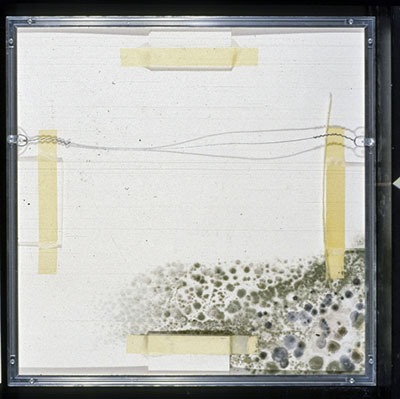
© Government of Canada, Canadian Conservation Institute. CCI 129965-0001
Figure 22. Mould colonies on the back of a poorly framed print. Their distribution shows the effect of a microclimate created by the varying distances between the backing board and a damp wall. Where the gap was wider (top of picture), ventilation could occur by convection; this prevented moisture from building up to levels that allow mould growth. Where the gap was narrow (bottom of picture), the convection of ventilation was restrained; this allowed enough moisture to support mould growth which spread to the backing board.
If a damp problem occurs due to a water leak or flood, restoring the situation as fast as possible is crucial. Any lowering of the RH, even if it remains relatively higher than normal, helps to delay mould growth and buys time to implement further response measures. For example, mould can take a mere two days to grow at 90% RH but may take as long as 10 days at 80% RH and 100 days at 70% RH.
Providing a stable RH with little fluctuation is a key preventive conservation strategy for RH-sensitive objects (as identified in Table 3).
Dry environments slow the deterioration of acidic papers (as discussed above) and should be considered for newsprint and low-quality, post-1850 papers. However, paper objects that are sensitive to RH fluctuations (as per Table 3) would not qualify because lowering the RH would impart stresses, which could cause splits (e.g. of hinged large sheets) or cracking/curling (e.g. of heavy gouache).
In summary:
- Maintain RH below 65%. Avoid high RH and prolonged periods of elevated RH (over 75%) to discourage mould growth.
- Based on the sensitivity of the collection, as per Table 3, define and implement enhanced RH controls.
- Install measuring instruments, and monitor and interpret the data.
- Store objects in boxes, containers or enclosures, or mat and frame them. Typical frames and storage enclosures provide protection from short-term fluctuations but will not protect paper from long-term or seasonal changes. Use storage containers/enclosures that are tightly sealed or in multiple layers (double or even triple) to increase RH protection. See also the recommendations under the section Enclosures.
- Use humidity-buffering materials such as silica gel. Use also paper-based products such as matboard inside enclosures. Paper-based products (e.g. matboard) used to make protective folders, window mats, etc. are hygroscopic, helping to reduce RH fluctuations inside enclosures. For the final backing board of frames, however, a more impermeable material (e.g. corrugated plastic board or foam board) should be used to provide better long-term protection from changes in RH.
- Make sure the air circulates well to minimize the possibility of mould growth. If necessary, fans can be used to provide air circulation in a room.
For further preventive conservation strategies for RH, consult Agent of deterioration: incorrect relative humidity.
Examples of preventive conservation practices
This section provides practical examples in the care of paper objects.
Improving an acidic storage box for mixed paper documents
Problem:
A poor-quality acidic storage box is housing a mixed group of acidic and non-acidic papers (Figure 23).
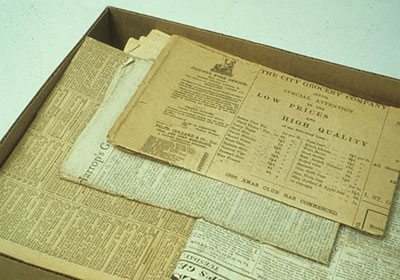
© Government of Canada, Canadian Conservation Institute. CCI 124703-0090
Figure 23. Improving storage for these paper objects involves replacing the acidic box with a more stable alternative.
Solution:
Replace the storage box with one made from acid-free buffered corrugated board or from good-quality plastic such as polyethylene or polypropylene.
Discoloured paper objects are likely to be acidic and should be isolated from the non-acidic papers to prevent cross-contamination. All documents would benefit from being placed in buffered paper folders or inert plastic folders, especially the more brittle acidic papers. Folders are preferred over envelopes because they allow easy access for handling (if the papers are acidic, they may be brittle and vulnerable to damage from handling).
Alternatively, if resources are not available for individual folders and for two separate containers, there are still benefits in making sure that the acidic papers are separated from the non-acidic papers by placing buffered interleaving tissue paper above and below them.
To minimize handling to determine what is inside, identify the contents on the outside of the enclosure.
Staining of a paper object caused by improper framing materials
Problem:
Many framed paper objects from the 19th century had shingles (often cedar) as backing boards. Often, differences in the concentration of acids and resins in the shingle caused staining that followed the grain of the wood (Figures 24a, 24b and 24c). These objects usually show an even darker stain at the gap between the shingles, indicating increased damage likely due to exposure to additional pollutants and high RH. An inert backing board prevents this kind of damage.
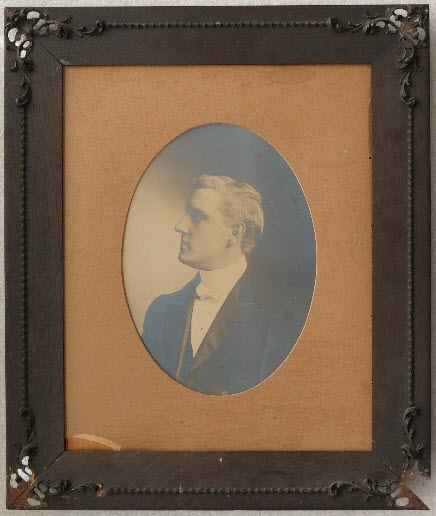
© S. Michalski
Figure 24a. The front of the framed object.
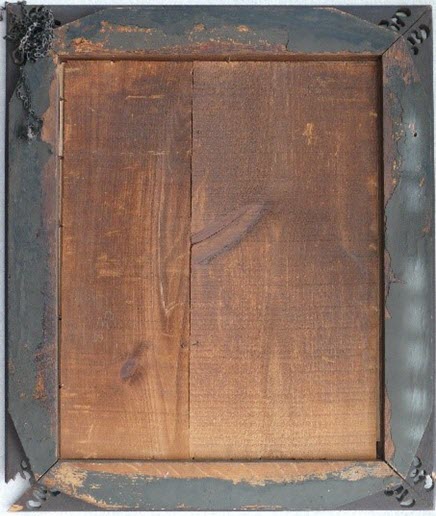
© S. Michalski
Figure 24b. The back of the frame.
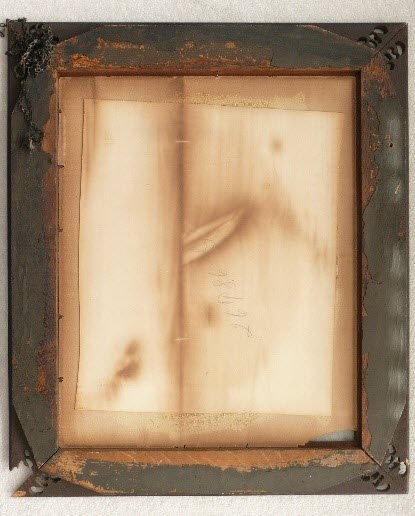
© S. Michalski
Figure 24c. The back of the object with the cedar shingles removed.
Solution:
RemoveFootnote 2 poor-quality matting and framing materials, except when the material is adhered to the paper object and removal would damage that object. Adhered material, discolouration and local stains require the expertise of a paper conservator. Store the paper object in a protective enclosure until it can be treated. Once treated, the object can be mattedFootnote 3 and framedFootnote 4 according to conservation guidelines.
Bibliography
Ashley-Smith, J., A. Derbyshire, and B. Pretzel. “The Continuing Development of a Practical Lighting Policy for Works of Art on Paper and Other Object Types at the Victoria and Albert Museum.” In ICOM-CC 13th Triennial Meeting, Rio de Janeiro, 22–27 September 2002, Preprints. London, UK: James & James, 2002, pp. 3–8.
Canadian Council of Archives. Basic Conservation of Archival Materials: A Guide. Rev. ed. Ottawa, ON: Canadian Council of Archives, 2003.
Canadian Conservation Institute. Making Enclosures for Books and Paper Objects. CCI Notes 11/1. Ottawa, ON: Canadian Conservation Institute, 1996.
Canadian Conservation Institute. Storing Works on Paper. CCI Notes 11/2. Ottawa, ON: Canadian Conservation Institute, 1995.
Canadian Conservation Institute. Glazing Materials for Framing Works on Paper. CCI Notes 11/3. Ottawa, ON: Canadian Conservation Institute, 1996.
Canadian Conservation Institute. Wheat Starch Paste. CCI Notes11/4. Ottawa, ON: Canadian Conservation Institute, 1993.
Canadian Conservation Institute. Basic Care of Books. CCI Notes 11/7. Ottawa, ON: Canadian Conservation Institute, 1995.
Canadian Conservation Institute. Display Methods for Books. CCI Notes 11/8. Ottawa, ON: Canadian Conservation Institute, 1994.
Canadian Conservation Institute. Framing Works of Art on Paper. CCI Notes 11/9. Ottawa, ON: Canadian Conservation Institute, 1995.
Canadian Conservation Institute. Encapsulation. CCI Notes 11/10. Ottawa, ON: Canadian Conservation Institute, 1995.
Canadian Conservation Institute. Framework for Preserving Heritage Collections (poster). Ottawa, ON: Canadian Conservation Institute, 2015.
Colby, K.M. “A Suggested Exhibition Policy for Works of Art on Paper.” Journal of the International Institute for Conservation-Canadian Group 17 (1992), pp. 3–11.
Colby, K.M. “A Suggested Exhibition/Exposure Policy for Works of Art on Paper.” Parts 1–3. In The Lighting Resource. Minneapolis, MN: The Lighting Resource, 2005.
Cowan, J., and S. Guild. Dry Methods for Surface Cleaning Paper. Technical Bulletin 11, revised. Ottawa, ON: Canadian Conservation Institute, 2001.
Derbyshire, A., and J. Ashley-Smith. “A Proposed Practical Lighting Policy for Works of Art on Paper at the V & A.” In ICOM-CC 12th Triennial Meeting, Lyon, 29 August–3 September 1999, Preprints. London, UK: James & James, 1999, pp. 38–41.
Ellis, M.H. The Care of Prints and Drawings. Nashville, TN: AASLH Press, 1987.
Ford, B., and N. Smith. “Lighting Guidelines and the Lightfastness of Australian Indigenous Objects at the National Museum of Australia.” (PDF format) In ICOM-CC 16th Triennial Conference, Lisbon, 19–23 September 2011, Preprints. Lisbon, Portugal: Critério, 2011.
Guild, S. Matting Works on Paper. CCI Notes 11/5. Ottawa, ON: Canadian Conservation Institute, 1997.
Guild, S., and M. MacDonald. Mould Prevention and Collection Recovery: Guidelines for Heritage Collections. Technical Bulletin 26. Ottawa, ON: Canadian Conservation Institute, 2004.
Tétreault, J. Products Used in Preventive Conservation. Technical Bulletin 32. Ottawa, ON: Canadian Conservation Institute, 2017.
Tremain, D. Removing Paper Artifacts from Their Frames. CCI Notes 11/6. Ottawa, ON: Canadian Conservation Institute, 1993.
© Government of Canada, Canadian Conservation Institute, 2018
Published by:
Canadian Conservation Institute
Department of Canadian Heritage
1030 Innes Road
Ottawa, ON K1B 4S7
Canada
Cat. No.: CH57-4/6-11-2018E-PDF
ISBN 978-0-660-28010-3